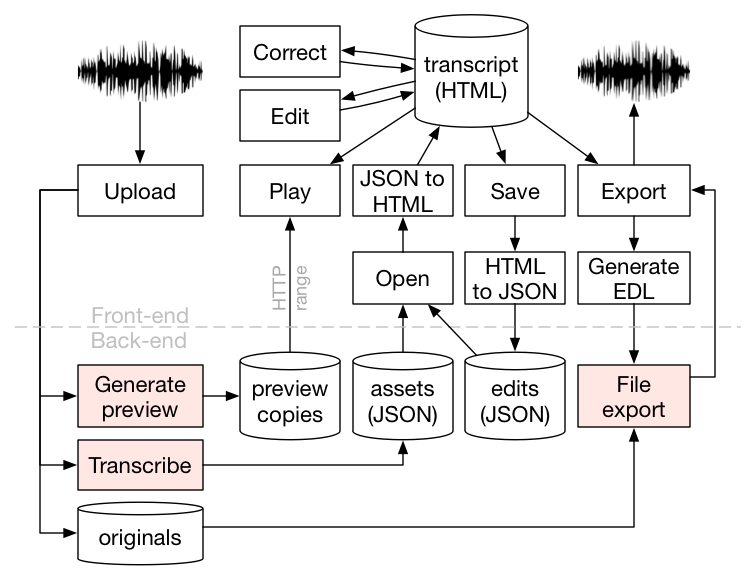Dialogger is an audio/video editor that allows you to navigate and edit recordings using a text-based interface.
- Playback and navigation using transcript
- Transcript editing
- Export of edit decision list (EDL)
- User accounts
- Asset management
The following features must be added manually for Dialogger to operate fully. Instructions and examples are provided.
- Speech-to-text
- Preview file generator
- File export

Conceptual flow diagram (excluded features shown in red)
- HTML/CSS/JS
- Text editing: CKEditor (LGPL)
- Media playback: HTML5 Video Compositor (Apache-2.0)
- UI framework: Semantic UI (MIT)
- MVC framework: Backbone (MIT)
- File upload: Dropzone (MIT)
- Node.js / Express
- Database: MongoDB (Apache-2.0)
- Authentication: Passport.js (MIT)
- Media info: Mimovie (MIT)
- Logging: Bunyan (MIT)
git clone https://github.com/bbc/dialogger.git && cd dialogger
docker-compose build
docker-compose up
Navigate to http://localhost:8080 and log in with username user and password password.
git clone https://github.com/bbc/dialogger.git && cd dialogger
curl -sL https://deb.nodesource.com/setup_6.x | sudo -E bash -
sudo -E apt-get install -y nodejs mediainfo mongodb
sudo -E npm install -g gulp bower bunyan
npm install
npm run build
(cd data && ./import.sh)
In config/consts.js, set the following parameters:
consts.portconsts.db.urlconsts.cookie.serverDomainconsts.cookie.serverPathconsts.files.root(ensure write permissions are set)
Run Dialogger using npm start, then log in with username user and password password.
Dialogger does not include the following key functionality, so you must add this in manually. Instructions on how to add this are provided below.
- Speech-to-text
- Preview file generator
- File export
Dialogger does not come with a speech-to-text system, so you will need to add some code to helpers/stt.js that
accepts a path to an audio/video file and returns the transcript and segmentation data.
Examples of the data formats are shown below, and an example can be found in helpers/stt-example.js.
{
words: [
{
word: "hello",
punct: "Hello",
start: 0.05,
end: 0.78,
confidence: 0.45
},
{
word: "world",
punct: "world.",
start: 1.13,
end: 1.45,
confidence: 0.9
}
]
}{
segments: [
{
start: 0.05,
duration: 2.34,
speaker: {
@id: "Bob",
gender: "M"
}
},
{
start: 2.34,
duration: 4.2,
speaker: {
@id: "Alice",
gender: "F"
}
}
]
}Preview files are low-bitrate versions of media files which are used for playback in the browser interface. To
configure preview file generation, you will need to add some code to helpers/previewfile.js. The function should
receive options in the following format, create a preview file and run the callback function.
{
inputPath: "/path/to/input/file",
outputPath: "/path/to/preview/version",
format: "audio", // can be audio or video
audio: {
acodec: "aac",
ab: "128k"
}
}File export allows users to download an edited version of their media. To configure file export, you will need to add
some code to helpers/fileexport.js. The function should receive options in the following format and return the path
of the edited file. In essence, what you want to do is to take the file path (asset.path) and the list of edits
(edl), produce an edited version of the file, then return the path.
{
// Information about the original file/asset
asset: {
description: "Asset description",
filename: "AssetFilename.wav",
path: "/path/to/original/file",
audio: {
channels: 2,
sampleRate: "48000"
}
},
// An array of in- and out-points, in seconds
edl: [
["78.38","102.89"],
["128.3","135.17"]
],
// User-provided options from the exportForm
// in public/js/editor.html
settings: {
audio: {
ab: "",
acodec: "pcm_s16le"
},
edlformat: "dira",
exportUnderlined:"true",
format: "audio",
id: "",
include: "true",
name: "test.wav",
video: {
height: "",
vb: "",
f: "mp4",
acodec: "aac",
ab: "",
vcodec: "libx264",
width: ""
}
}
}Please report any problems or make feature requests by raising an issue. Pull requests are also welcome.
- Chris Baume, BBC Research and Development